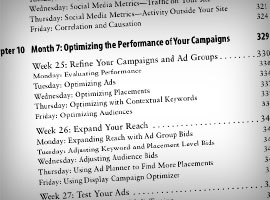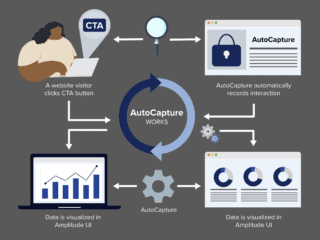To know, to share, and to be our partners’ competitive advantage. That’s the purpose we live by at Cardinal Path, and when we find opportunities to share the knowledge that can help advertisers win in the marketplace, we tend to take them.
Most recently, this has taken the form of Display Advertising: An Hour A Day, a book that Corey Koberg and I have spent many months writing and was released by SYBEX / Wiley just this month.
A Fast Moving Industry
 We’re living through a digital revolution, where the volume, sophistication, and availability of data coupled with technology has enabled unprecedented advances in advertising. We’ve seen how search engines have turned traditional marketing upside down and given rise to new disciplines of search engine optimization and search engine marketing. We’ve been lucky enough to be a part of the transformational impact that web analytics and data have had on the measurability and accountability of advertising spend. But somehow, for many advertisers, display advertising had maintained the perception that it’s “just those banner ads,” or that it’s something that only the biggest companies do strictly for branding purposes, or even that it’s simply some kind of extension of a print ad to the web. Then, something changed, and suddenly display started to get a little more attention. Facebook came along with some incredibly exciting targeting potential and Google completely revamped their Content Network, rebranding as the Google Display Network and rolling out feature after feature, making display advertising accessible to anyone with an AdWords account. Retargeting platforms started gaining enormous momentum and video became a ubiquitous piece of the web regardless of what device you might be viewing it from.
We’re living through a digital revolution, where the volume, sophistication, and availability of data coupled with technology has enabled unprecedented advances in advertising. We’ve seen how search engines have turned traditional marketing upside down and given rise to new disciplines of search engine optimization and search engine marketing. We’ve been lucky enough to be a part of the transformational impact that web analytics and data have had on the measurability and accountability of advertising spend. But somehow, for many advertisers, display advertising had maintained the perception that it’s “just those banner ads,” or that it’s something that only the biggest companies do strictly for branding purposes, or even that it’s simply some kind of extension of a print ad to the web. Then, something changed, and suddenly display started to get a little more attention. Facebook came along with some incredibly exciting targeting potential and Google completely revamped their Content Network, rebranding as the Google Display Network and rolling out feature after feature, making display advertising accessible to anyone with an AdWords account. Retargeting platforms started gaining enormous momentum and video became a ubiquitous piece of the web regardless of what device you might be viewing it from.
Why Write a Book About Display?
 The truth is, the current display advertising landscape is as complex as it is exciting, and when we spent time talking to our clients about the massive opportunity that exists, what we found is that while search is reaching ever higher levels of maturity, to many people display is still a bit of a mystery. When we looked around to see what resources are out there for people to turn to, there just wasn’t much on display, and this book is an opportunity to remove some of that mystery and get people taking advantage of all that display advertising can do.
The truth is, the current display advertising landscape is as complex as it is exciting, and when we spent time talking to our clients about the massive opportunity that exists, what we found is that while search is reaching ever higher levels of maturity, to many people display is still a bit of a mystery. When we looked around to see what resources are out there for people to turn to, there just wasn’t much on display, and this book is an opportunity to remove some of that mystery and get people taking advantage of all that display advertising can do.
We’re a long way from calling up a website owner and negotiating a price to stick our skyscraper ad on the side of their homepage for a month, and all the sophistication and advertising space that was once exclusive to the big budgets of the enterprise is now available to just about anyone. We wanted to share what we know of display with marketers, business owners, agencies, and anyone else that wants to wander down the rabbit hole of display advertising.
What Did We Learn Writing This Book?
 During the process of getting this book from concept to paperback, we learned a lot about this space, and rather than giving an overview of what content we covered and what you’ll find in the pages, here are some observations that live between the lines of text.
During the process of getting this book from concept to paperback, we learned a lot about this space, and rather than giving an overview of what content we covered and what you’ll find in the pages, here are some observations that live between the lines of text.
- Display is growing and changing by the minute. In the time it took to take the final drafts of these chapters and get them printed, a long list of additions and updates was already in place. During the almost full year of writing, every single chapter needed to be rewritten at least once due to advances in the industry and changes to the platforms. We’re expecting this rapid pace to continue and offer advertisers even more tools and features.
- Display is becoming less about the placement and more about the audience. It wasn’t that long ago that you picked which websites you wanted your ad to show up on based on the content of the site. You were guessing that the kind of person you wanted to buy your products and services might go to a site like the one you picked. Now, we can target the audience itself, regardless of what websites they might go to. You’re not running your ads about sports products on sports websites anymore; you’re putting your ads in front of sports consumers no matter where they happen to be browsing.
- Display is for branding AND direct response. Of course the images, rich media, and video formats along with the massive reach have made display advertising a no-brainer for branding and positioning objectives, but the idea of using display advertising for direct response advertising and actual revenue-producing performance is a little surprising to many people. Advances in multi-session analytics and the way we can view different touch points along various paths to conversion coupled with intelligent attribution modeling can assign the proper value to advertising and interactions from the top of the conversion funnel all the way through to the purchase.
- Technology and data are enabling automation in decision making. This certainly isn’t unique to display, but we’re seeing technology take an ever-increasing role in making decisions around what media to buy. Real-time-bidding is a reality and demand side platforms can crunch huge amounts of data to decide whether or not to bid for an ad slot, and if so, exactly how much to bid in order to maximize profitability. All of this happens in about a third of the time it takes a human being to blink, and it happens every single time those ad-carrying pages are loaded…all day, every day. Even on the less sophisticated side, self-serve platforms like AdWords offer conversion based automated bidding models and automated campaign optimization.
- There are challenges ahead for us to face. As with any nascent technology, the industry is learning and changing. Ultimately, the collective group of advertisers and consumers will need to figure out what levels of privacy need to be established and respected. Consumers are just starting to realize just how much data they generate for advertisers by living their lives online, and it can be a bit scary, even if it is mostly anonymous (most display targeting doesn’t target a name or an email or a social security number, but an anonymous ID). On the other hand, the Internet is largely an ad-supported entity, and if you have to see ads, wouldn’t you rather see ads that are relevant to you?
Our hope is that through writing this book, advertisers large and small can see what’s already possible with display advertising and the data that drives it so they can leverage it now and be ready for what the future brings.
What do you think of display and where it’s going? We’d love to hear how you’re using display, what results you’re achieving and where you see the future heading!
















